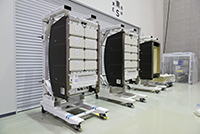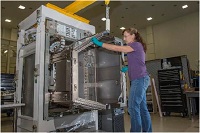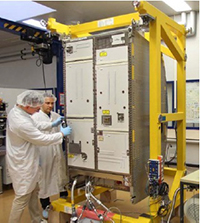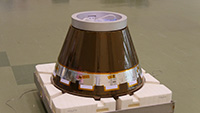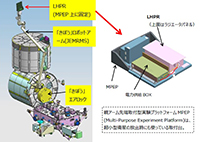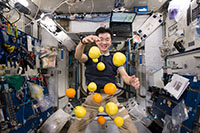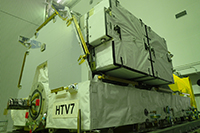Cargo in the pressurized Logistic Carrier (PLC)
Experiment racks
- Two US experiment racks (Express Rack 9B and 10B)
-
US EXPRESS Racks 9B and 10B will be delivered on this flight. These two EXPRESS Racks are modified for more simple interfaces.
- US Life Sciences Glovebox (LSG)
-
Life Sciences Glovebox (LSG), the second ISS large-scale glovebox for scientific experiments, will be installed on board “Kibo”.
- Life Support Rack (LSR)
-
The Life Support Rack (LSR) developed by the European Space Agency (ESA) is equipment for demonstration test of effective life support system which produces oxygen (O2) from water (H2O) by using electrolysis and also converts the produced hydrogen (H2) in Sabatier reaction with carbon dioxide (CO2), removed from the inside of the cabin, into methane (CH4) and byproduct water (H2O), which is then recycled for electrolysis.
Utilization/experiment-related items
- HTV Small Re-entry Capsule (HSRC)
-
HTV Small Re-entry Capsule (HSRC) will demonstrate reentry technology and cargo recovery function from the ISS.
HSRC including experiment samples will be attached to the hatch of the Pressurized Logistic Carrier (PLC) before the HTV7 unberthing from ISS. HSRC will be separated from the HTV7 after its deorbit burn; re-enter Earth’s atmosphere; descend by parachute; and be recovered after splashdown.
【Reference】 HTV Small Re-entry Capsule (HSRC)
The Loop Heat Pipe is expected for high efficiency heat rejection technology for future spacecraft. This Loop Heat Pipe Radiator (LHPR) demonstration will perform on-orbit technology demonstration of an expansion-type radiator equipped with a loop heat pipe by using “Kibo” as a test bed environment.
The demonstration aims to reduce risks in satellite development by reflecting the results obtained by the on-orbit demonstration to the design of the expansion-type radiator, which will be applied to Engineering Test Satellite-9 aimed at the realization of next-generation geostationary communications satellites.
- JEM Small Satellite Orbital Deployer (J-SSOD) and CubeSat
-
This mission will mark the 10th CubeSat deployment using J-SSOD since 2012.
【Reference】CubeSats which have been deployed until now
- CubeSat
-
HTV7 will deliver following CubeSats developed by a joint team of Nanyang Technological University (NTU, in Singapore) and Kyushu Institute of Technology (“Kyutech”, in Japan), general incorporated association Rymansat Spaces, and Shizuoka University.
- SPATIUM-I (Kyushu Institute of Technology/Nananyang Technological University)
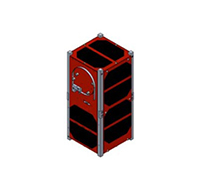
SPATIUM-I (2U sized)
The CubeSat will perform a mission to demonstrate technology aimed at electron density measurement and three-dimensional mapping of ionosphere and chip scale (ultra-small) atomic clock for CubeSats.
- The CubeSat will perform a mission to demonstrate technology aimed at electron density measurement and three-dimensional mapping of ionosphere and chip scale (ultra-small) atomic clock for CubeSats.
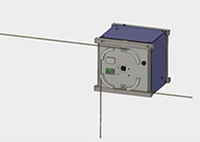
RSP-00 (1U sized)
The CubeSat will demonstrate technology for imaging with onboard camera and high speed data transmission.
- STARS-Me (Shizuoka University)
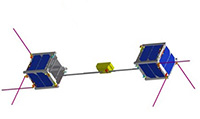
STARS-Me (2U sized)
The CubeSat will perform small-scale demonstration of space elevator, which is a demonstration mission of configuration of two satellites and a climber (moving mechanism).
- Fresh food
-
Following HTV5 and HTV6, HTV7 will also deliver foods and other supplies including Fresh food.
- ISS battery Orbital Replacement Units (ORUs)
-
Following the HTV6, the HTV7 (and also HTV8 and HTV9) will deliver new lithium ion batteries for ISS on the Exposed Pallet (EP) on the Unpressurized Logistic Carrier (ULC). New six battery Orbital Replacement Units (ORUs) consisting of new lithium-ion battery cells manufactured by a Japanese company are delivered.
The nickel-hydrogen batteries currently used on the ISS are becoming old. The extension of ISS operations becomes possible with the supply of Japanese lithium-ion battery cells. Only the HTV is capable of delivering six battery ORUs at one time, and thus plays an important role in continuous ISS operations.

